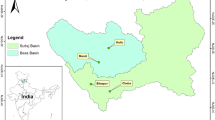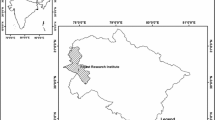Abstract
The objective of this study was to test an artificial neural network (ANN) for estimating the evaporation from pan (E Pan) as a function of air temperature data in the Safiabad Agricultural Research Center (SARC) located in Khuzestan plain in the southwest of Iran. The ANNs (multilayer perceptron type) were trained to estimate E Pan as a function of the maximum and minimum air temperature and extraterrestrial radiation. The data used in the network training were obtained from a historical series (1996–2001) of daily climatic data collected in weather station of SARC. The empirical Hargreaves equation (HG) is also considered for the comparison. The HG equation calibrated for converting grass evapotranspiration to open water evaporation by applying the same data used for neural network training. Two historical series (2002–2003) were utilized to test the network and for comparison between the ANN and calibrated Hargreaves method. The results show that both empirical and neural network methods provided closer agreement with the measured values (R 2 > 0.88 and RMSE < 1.2 mm day−1), but the ANN method gave better estimates than the calibrated Hargreaves method.





Similar content being viewed by others
References
Allen RG, Pereira LS, Raes D, Smith M (1998) Crop evapotranspiration: guidelines for computing crop water requirements. Irrigation and Drainage Paper No. 56, FAO, Rome
Bruton JM, Mcclendon RW, Hoogenboom G (2000) Estimating daily pan evaporation with artificial neural networks. Trans ASAE 43(2):491–496
Coulibaly P, Anctil F, Bobee B (2000) Daily reservoir inflow forecasting using artificial neural networks with stopped training approach. J Hydrol 230(3–4):244–257
Droogers P, Allen RG (2002) Estimating reference evapotranspiration under inaccurate data conditions. Irrig Drain Syst 16:33–45
Hargreaves LG, Hargreaves GH, Riley JP (1985) Irrigation water requirements for Senegal River Basin. J Irrig Drain Eng 111(3):265–275
Irmak S, Haman D, Jones W (2002) Evaluation of class a pan coefficients for estimating reference evapotranspiration in humid location. J Irrig Drain Eng 128(3):153–159
Keskin ME, Terzi O (2006) Artificial neural network models of daily pan evaporation. J Hydrol Eng 11(1):65–70
Penman HL (1948) Natural evaporation from open water, bare soil and grass. R Soc London Proc Ser A 193:120–146
Sudheer KP, Gosain AK, Ramasastri KS (2003) Estimating actual evapotranspiration from limited climatic data using neural computing technique. J Irrig Drain Eng 129(3):214–218
Valiantzas JD (2006) Simplified versions for the Penman evaporation equation using routine weather data. J Hydrol 331:690–702
Acknowledgments
This study is the partial work of Project No. 7351023/1/02 supported by University College of Abourayhan, University of Tehran and was done in department of Irrigation and Drainage Engineering. The meteorological data were provided from Iran Meteorological Organization.
Author information
Authors and Affiliations
Corresponding author
Rights and permissions
About this article
Cite this article
Rahimikhoob, A. Estimating daily pan evaporation using artificial neural network in a semi-arid environment. Theor Appl Climatol 98, 101–105 (2009). https://doi.org/10.1007/s00704-008-0096-3
Received:
Accepted:
Published:
Issue Date:
DOI: https://doi.org/10.1007/s00704-008-0096-3




